Reminiscing

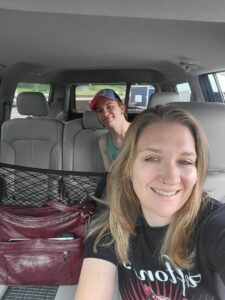 My grandnephew, Chris Spicer graduated from high school last year, and now, in college, he is doing great. He is studying graphic design, and he has a real knack for it. Chris, like most young people his age, is very good with technology. I wasn’t totally sure what graphic design was all about. This is what I found. “Graphic design is a profession, academic discipline, and applied art whose activity consists in projecting visual communications intended to transmit specific messages to social groups, with specific objectives. Graphic design is an interdisciplinary branch of design and of the fine arts. Its practice involves creativity, innovation and lateral thinking using manual or digital tools, where it is usual to use text and graphics to communicate visually.” As to what fields will be open to Chris, I found, “The role of the graphic designer in the communication process is that of the encoder or interpreter of the message. They work on the interpretation, ordering, and presentation of visual messages. Usually, graphic design uses the aesthetics of typography and the compositional arrangement of the text, ornamentation, and imagery to convey ideas, feelings, and attitudes beyond what language alone expresses. The design work can be based on a customer’s demand, a demand that ends up being established linguistically, either orally or in writing, that is, that graphic design transforms a
My grandnephew, Chris Spicer graduated from high school last year, and now, in college, he is doing great. He is studying graphic design, and he has a real knack for it. Chris, like most young people his age, is very good with technology. I wasn’t totally sure what graphic design was all about. This is what I found. “Graphic design is a profession, academic discipline, and applied art whose activity consists in projecting visual communications intended to transmit specific messages to social groups, with specific objectives. Graphic design is an interdisciplinary branch of design and of the fine arts. Its practice involves creativity, innovation and lateral thinking using manual or digital tools, where it is usual to use text and graphics to communicate visually.” As to what fields will be open to Chris, I found, “The role of the graphic designer in the communication process is that of the encoder or interpreter of the message. They work on the interpretation, ordering, and presentation of visual messages. Usually, graphic design uses the aesthetics of typography and the compositional arrangement of the text, ornamentation, and imagery to convey ideas, feelings, and attitudes beyond what language alone expresses. The design work can be based on a customer’s demand, a demand that ends up being established linguistically, either orally or in writing, that is, that graphic design transforms a 
 linguistic message into a graphic manifestation.” It sounds like very interesting work, with lots of potential. Chris is taking some summer classes, so that he can graduate next spring. It’s an ambitious goal, but he can do it.
linguistic message into a graphic manifestation.” It sounds like very interesting work, with lots of potential. Chris is taking some summer classes, so that he can graduate next spring. It’s an ambitious goal, but he can do it.
While he is in college, Chris is also working at Ace Hardware. He has worked there before, in Rawlins, and now that he and his mom, Andrea Beach moved to Casper, it seemed like the perfect job for his college days. Chris is very good at his job. He gives great customer service, and always with a smile. With his background in color and design, Chris has become the go-to paint guy. With his art classes, he has become very knowledgeable with color theory and how mixing paint works. That is a valuable asset in the world of paint colors.
Chris is still close friends with a group of friends from high school, and even though he has moved away, they make frequent trips to Casper to visit him. Often, when high school is over, friends go their own way, and drift 
 apart. It’s hard to keep up with old friends, because everyone has their own lives. Chris’ friends are the exception, but that could change as the years go by, as we all know. It’s nice that they can remain close, for now anyway. Chris still hangs out quite a bit with his mom too. They have been close all his life, and they enjoy doing things together, like concerts, movies, hikes, and walks. He also likes to spend time with his cousins, Xander, Zack, and Isaac Spethman, as well as their sister, Aleesia Spethman. And each year, Chris, his mom, and his grandma, Caryl Reed take a trip to the Black Hills. It’s been a long-standing tradition that they love doing each year…and this year it is on his birthday, so that’s extra special. Today is Chris’ birthday. Happy birthday Chris! Have a great day! We love you!
apart. It’s hard to keep up with old friends, because everyone has their own lives. Chris’ friends are the exception, but that could change as the years go by, as we all know. It’s nice that they can remain close, for now anyway. Chris still hangs out quite a bit with his mom too. They have been close all his life, and they enjoy doing things together, like concerts, movies, hikes, and walks. He also likes to spend time with his cousins, Xander, Zack, and Isaac Spethman, as well as their sister, Aleesia Spethman. And each year, Chris, his mom, and his grandma, Caryl Reed take a trip to the Black Hills. It’s been a long-standing tradition that they love doing each year…and this year it is on his birthday, so that’s extra special. Today is Chris’ birthday. Happy birthday Chris! Have a great day! We love you!
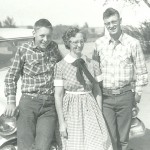
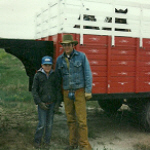 My husband’s uncle, Bernard “Butch” Hein was a cattle rancher in Forsyth, Montana. Butch came into ranching by birth, coming from a long line of ranchers. Butch raised cattle, and since I have been able to eat and later buy some of the beef he raised, I can tell you that it tasted excellent. I think most of us thought that the iconic rancher would always be there, but on October 13, 2023, that all came to a tragic end, when Uncle Butch was killed in a car accident. It was such a shock to so many people. You are never prepared to lose a loved one, but when it happens to someone who was still so full of life, it is even more of a shock.
My husband’s uncle, Bernard “Butch” Hein was a cattle rancher in Forsyth, Montana. Butch came into ranching by birth, coming from a long line of ranchers. Butch raised cattle, and since I have been able to eat and later buy some of the beef he raised, I can tell you that it tasted excellent. I think most of us thought that the iconic rancher would always be there, but on October 13, 2023, that all came to a tragic end, when Uncle Butch was killed in a car accident. It was such a shock to so many people. You are never prepared to lose a loved one, but when it happens to someone who was still so full of life, it is even more of a shock.
Butch never really wanted to be anything else but a rancher, but of course, when he graduated from high school the Vietnam War was in full swing, and Butch was drafted into the Navy. That era was a tough time for a lot of people. Many people felt like the United States was in a war that was a “no-win situation,” and we should  get out of it. There were protests and a whole lot of hate going around. There were people who dodged the draft by running to Canada. Not Butch though. He and his older brother, Eddie both served. Eddie was in the Army. The brothers served honorably, and both came home. They loved their country, and we are so proud of both of them.
get out of it. There were protests and a whole lot of hate going around. There were people who dodged the draft by running to Canada. Not Butch though. He and his older brother, Eddie both served. Eddie was in the Army. The brothers served honorably, and both came home. They loved their country, and we are so proud of both of them.
After his discharge, Butch came home, met, and married Bonnie Wertz. They started a family, and for a time everything was great. They had a son and were expecting a daughter, but Bonnie was sick. They hoped to have their daughter and get treatment to save Bonnie. Unfortunately, Butch lost both of them. Then, it was just Butch and his son, Scott. Still, they were together, and when he grew up, Scott got married to Terri Wiederrick. They had three beautiful children, Laura, Carson, and Lindsey. Scott and his son Carson both wanted to be in ranching, and now, they have taken over the ranch, which is bittersweet for them. Their dream was to take over the ranch someday, but the plan was to be when Butch retired, not this way. Now, the ranch belongs to Scott, but there is something missing. His dad was supposed to be there in an advisory capacity if nothing else.
Scott and his family aren’t the only ones who feel the loss. Nor is the rest of our family. Butch used to go to the 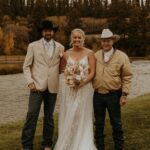
 same hang out most mornings to meet up with friends for coffee and breakfast. I’ve heard that there are people in that group who just can’t go anymore. It just hurts too much. I suppose some of those people will eventually go back, and I would assume that Butch wouldn’t want them to stop going. Still, it may be a while before they go back, because I think it will be a very long time before we will be able to face the loss and how it happened. Today would have been Butch’s 79th birthday. Happy birthday in Heaven Uncle Butch. We love and miss you very much.
same hang out most mornings to meet up with friends for coffee and breakfast. I’ve heard that there are people in that group who just can’t go anymore. It just hurts too much. I suppose some of those people will eventually go back, and I would assume that Butch wouldn’t want them to stop going. Still, it may be a while before they go back, because I think it will be a very long time before we will be able to face the loss and how it happened. Today would have been Butch’s 79th birthday. Happy birthday in Heaven Uncle Butch. We love and miss you very much.
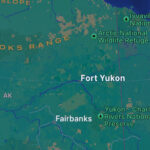
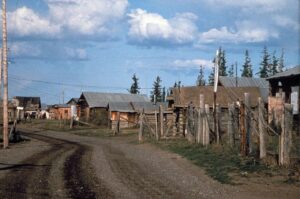 Fort Yukon is a city in the Yukon-Koyukuk Census Area in the state of Alaska. The city actually straddles the Arctic Circle. Most of the people who live there are Alaskan natives from the Gwich’in tribe. This “city” is barely a village by the standards most of us use. In the 2020 census, there were 428 people living there, and that was down from the 2000 census, when the city boasted 595 people. According to the United States Census Bureau, Yukon City occupies a total area of 7.4 square miles, of which 7.0 square miles is land and 0.4 square miles is water. It’s not that “nobody” comes from Fort Yukon, because Fort Yukon was the hometown of the late Alaska Congressman Don Young. Still, I heard someone joke once about asking if any famous people were born in a certain place, and the old man they asked said, “Nope, only babies.” Hahaha!! I suppose that’s true. What we become doesn’t depend on where we were born, but rather on who we choose to become.
Fort Yukon is a city in the Yukon-Koyukuk Census Area in the state of Alaska. The city actually straddles the Arctic Circle. Most of the people who live there are Alaskan natives from the Gwich’in tribe. This “city” is barely a village by the standards most of us use. In the 2020 census, there were 428 people living there, and that was down from the 2000 census, when the city boasted 595 people. According to the United States Census Bureau, Yukon City occupies a total area of 7.4 square miles, of which 7.0 square miles is land and 0.4 square miles is water. It’s not that “nobody” comes from Fort Yukon, because Fort Yukon was the hometown of the late Alaska Congressman Don Young. Still, I heard someone joke once about asking if any famous people were born in a certain place, and the old man they asked said, “Nope, only babies.” Hahaha!! I suppose that’s true. What we become doesn’t depend on where we were born, but rather on who we choose to become.
We normally think of Alaska as a frozen tundra that never thaws, and there are places in Alaska that don’t, but then there are places elsewhere that normally don’t thaw too, and they are much further south than Alaska. While Fort Yukon can have pretty cold temperatures, they also hold the state record for the highest temperature, which was 100°F too. Until 1971, Fort Yukon held the all-time lowest temperature record for Alaska and the United States at ?78 °F, and it still holds the record for the lowest mean monthly temperature when the notoriously cold month of December 1917 had an average daily temperature of ?48.3 °F and the minimum averaged ?58 °F. That has got to be the most extreme temperature shift anywhere. Of course, it didn’t happen in one day, so people might not have noticed that. You would have to brave those really cold temperatures, but if you did, you would find that Fort Yukon is among the best places in the world for observing the Aurora Borealis…someday, maybe I’ll get there for that. In the summer Fort Yukon has midnight sun and in December the sun appears for only a few hours each day…another interesting tidbit of information.
.
Originally Fort Yukon was a trading post established by Alexander Hunter Murray of the Hudson’s Bay Company, on June 25, 1847. He wanted to let people know about the place, so Murray drew numerous sketches of fur trade posts and of people and wrote the Journal of the Yukon, 1847–48, which gave valuable insight into the culture of the Gwich’in at the time. At the time, the post was in Russian America, the Hudson’s Bay Company continued to trade there until the American traders expelled it in 1869, following the Alaska Purchase when the Alaska Commercial Company took over the post.
The Klondike Gold Rush brough the largest influx of people to the area in the winter of 1897–1898. During that time, Fort Yukon received two hundred prospectors from Dawson City, which was short on supplies. A post office was established on July 12, 1898, with John Hawksly as its first postmaster. The settlement suffered over the following decades as a result of several infectious disease epidemics and a 1949 flood, but it was revived in the 1950s, when the United States Air Force established a base and radar station there. The town was officially 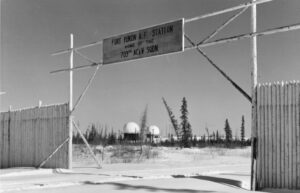
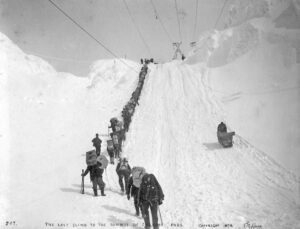 incorporated in 1959. Probably some of the best things that could have happed to Fort Yukon was its newly established value as a tourist destination, which came about in the late 20th century, due in part to its extreme northerly location and its proximity to Fairbanks. I’ve been to Alaska, but not to this area. Alaska holds a lifelong interest for me, but I’m not sure I could be a full-time resident of the area. Still, I’d like to visit again, and this time maybe in the Winter.
incorporated in 1959. Probably some of the best things that could have happed to Fort Yukon was its newly established value as a tourist destination, which came about in the late 20th century, due in part to its extreme northerly location and its proximity to Fairbanks. I’ve been to Alaska, but not to this area. Alaska holds a lifelong interest for me, but I’m not sure I could be a full-time resident of the area. Still, I’d like to visit again, and this time maybe in the Winter.
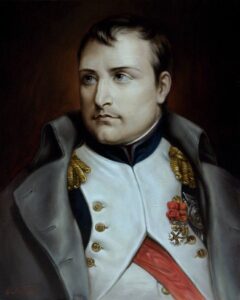
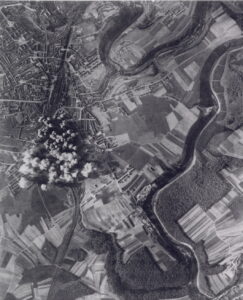 With summer comes thunderstorms in many areas of the world. Lake Maracaibo in Venezuela has been listed as the lightning capital of the world, with storms lighting up the skies almost 300 nights each year, according to a NASA study. Lightning kills approximately 73 people a year in the United States alone. Most strikes kill one victim at a time, but on June 26, 1807, lightning hit a gunpowder factory in the small European country of Luxembourg, and that day, the lightning killed more than 300 people. The Luxembourg disaster may have been the deadliest lightning strike in history.
With summer comes thunderstorms in many areas of the world. Lake Maracaibo in Venezuela has been listed as the lightning capital of the world, with storms lighting up the skies almost 300 nights each year, according to a NASA study. Lightning kills approximately 73 people a year in the United States alone. Most strikes kill one victim at a time, but on June 26, 1807, lightning hit a gunpowder factory in the small European country of Luxembourg, and that day, the lightning killed more than 300 people. The Luxembourg disaster may have been the deadliest lightning strike in history.
Luxembourg was occupied by Napoleon’s army in 1807. The French dictator used the country to stockpile weapons and ammunition, or shall we say hide them from the view of those he didn’t want to know about them. Napoleon built a number of underground bunkers for this very purpose. In the southern part of Luxembourg city of Kirchberg, a fortress built in 1732 was used as an armory. It was here, on June 26, when lightning struck the fortress that disaster followed. When lightning struck, the ammunition located in the structure ignited on contact. The explosion that followed was massive. The blast took out two entire blocks, which caused several other fires to rage nearby. The London Times later reported, “This city has been plunged into the greatest consternation and distress.” This strike has been considered one of the worst lightning disasters of all time…mostly because of the number of lives lost.
The earth receives 8 to 9 million lightning strikes every day…wow!! The United States alone sees about 70,000 thunderstorms a typical year. In those storms, approximately 20 million lightning strikes are produced in a year. Lightning can create beautiful shots for photographers, and I doubt if there is one person who can honestly say they are not enamored with the beauty of lightning, but the thing to understand is that a bolt of lightning can reach 50,000 degrees Fahrenheit in that instant when it strikes. In that beauty hides an average of 100 million volts of electricity, and a lightning bolt can be as much as five miles long. Lightning can strike from a storm that is miles away, so when you hear that rumble, it really is time to seek shelter. Of course, you can and should act in a preventative way when it comes to lightning safety. Keep an eye on the forecast and plan with the weather in mind, especially if those plans were going to take you near the water. Beaches are dangerous because lightning tends to strike the highest object, and water is a good conductor of electricity, so you don’t want to be 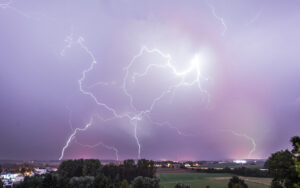
 in it. If someone nearby does get hit by lightning, remember that the lightning victim doesn’t hold the electric charge. Call 911 and begin first aid right away. About 90% of lightning victims survive, but they need immediate medical attention. Remember, that while lightning is beautiful, it is best viewed from a safe place indoors.
in it. If someone nearby does get hit by lightning, remember that the lightning victim doesn’t hold the electric charge. Call 911 and begin first aid right away. About 90% of lightning victims survive, but they need immediate medical attention. Remember, that while lightning is beautiful, it is best viewed from a safe place indoors.

 Since my daughter, Amy Royce’s family moved to Washington state, my grandson, Caalab Royce has really enjoyed exploring the area. When he first moved up there, he would go out walking the trails for hours, and on the visits we have made to see them, he has often hiked with us. Of course, he isn’t the only one that hiked, but he does enjoy doing it what he can. Caalab also likes to go on drives and listen to music. That isn’t surprising, since Caalab and his dad, Travis Royce “jam” with a group of friends every week. Their band is something they really enjoy. Personally, I think they are very good.
Since my daughter, Amy Royce’s family moved to Washington state, my grandson, Caalab Royce has really enjoyed exploring the area. When he first moved up there, he would go out walking the trails for hours, and on the visits we have made to see them, he has often hiked with us. Of course, he isn’t the only one that hiked, but he does enjoy doing it what he can. Caalab also likes to go on drives and listen to music. That isn’t surprising, since Caalab and his dad, Travis Royce “jam” with a group of friends every week. Their band is something they really enjoy. Personally, I think they are very good.
Another thing Caalab shares with his dad is woodworking. They both like building things, especially with wood. The two are really best friends, and they are always doing 
 “some kind of man stuff” according to Caalab’s sister, Shai Royce. Caalab also helps with Travis’ backyard projects. Recently, the part of the fence blew down, so they built a new fence on that whole side. Travis and Amy love having a beautiful backyard oasis, and Caalab has been a big help to his dad in that respect. Caalab helped dig the ponds and lay the patio bricks.
“some kind of man stuff” according to Caalab’s sister, Shai Royce. Caalab also helps with Travis’ backyard projects. Recently, the part of the fence blew down, so they built a new fence on that whole side. Travis and Amy love having a beautiful backyard oasis, and Caalab has been a big help to his dad in that respect. Caalab helped dig the ponds and lay the patio bricks.
Travis holds a monthly poker night that Caalab always goes to. He likes to play poker and enjoys getting together to play. The whole family likes to visit the local casinos, and I don’t know how, but they win a lot!! I haven’t really asked they how much money they spent or lost, but I’ve seen the wins, and they are impressive. The family likes to attend the Bellingham Bells baseball games. They often go with friends, but Travis and Caalab are always “two of a kind” there, as are they in most ways. They are both so funny. They love a good joke…and a good prank, and while Shai 
 doesn’t always appreciate Caalab’s antics, she forgives him for being a pest, because she loves her brother.
doesn’t always appreciate Caalab’s antics, she forgives him for being a pest, because she loves her brother.
Shai often dog sits for some friends, and Walter, one of the dogs absolutely loves Caalab. Walter waits for Caalab to come home or to get up in the morning. Caalab is Walter’s best friend. Hahahaha!! It’s not surprising, because Caalab has always loved dogs and they have all loved him. I think Caalab likes that Shai dog sits as much as she does. Today is Caalab’s birthday. Happy birthday Caalab!! Have a great day!! We love you!!

 Much has happened in the first year of my grandson, Josh Petersen and his wife, Athena’s marriage. In addition to their first son, Justin, they now have a second son, named Axel, and a baby on the way. Josh and Athena are very family oriented. They love kids and have said they want four or five, so this newest addition isn’t a surprise. These “kids” are so happy and full of excitement every day. For them, life is an adventure, and they can’t wait for the next chapter.
Much has happened in the first year of my grandson, Josh Petersen and his wife, Athena’s marriage. In addition to their first son, Justin, they now have a second son, named Axel, and a baby on the way. Josh and Athena are very family oriented. They love kids and have said they want four or five, so this newest addition isn’t a surprise. These “kids” are so happy and full of excitement every day. For them, life is an adventure, and they can’t wait for the next chapter.
Josh and Athena met when they were in middle school, but it wasn’t until much later, that they knew that this was forever. Their love is real and true, and even if they knew that back in middle school, they couldn’t have married, so it’s just as well that they found out later in life. They truly are perfect for each other, and they 
 couldn’t be happier with their lives…or their family. Not everyone can say that they have known their spouse for much of their lives, but it is really cool when they can, and when they are still in love even after their school days are long over. These kids have their priorities straight…God first, family second, and self, last. I love that they are dedicated to God and family. I love seeing their faith in action.
couldn’t be happier with their lives…or their family. Not everyone can say that they have known their spouse for much of their lives, but it is really cool when they can, and when they are still in love even after their school days are long over. These kids have their priorities straight…God first, family second, and self, last. I love that they are dedicated to God and family. I love seeing their faith in action.
They love taking the kids to the different parks and even the mall to play on the toys there. At this age, the boys are happy with whatever toys are around, and that, in turn makes Mommy and Daddy happy. That will end, of course, as the boys start hearing about the latest and greatest new toys, but for now, Josh and Athena can enjoy the simplicity of having young kids. Of course, it helps that the parents have no problem playing with 
 the kids, even going into the maze toys. Let’s face it, most of us couldn’t even get in there. I think Josh and Athena are really big kids at heart.
the kids, even going into the maze toys. Let’s face it, most of us couldn’t even get in there. I think Josh and Athena are really big kids at heart.
Josh is a Fire Extinguisher Tech for All Out Fire. He works very hard so that Athena can stay home with their kids and their coming little one. Athena is an excellent mommy and the boys are very blessed to have her for their mom. She and the kids have great days of reading and learning…and playing, but when their daddy gets home, they are all so happy to see him. These boys are Daddy’s Boys, in the evening anyway. During the days, it’s all about Mommy. They family is all about family and growing in love every day. Today is Josh and Athena’s first anniversary. Happy Anniversary Josh and Athena!! Have a great day!! Congratulations!! We love you!!

 My grandniece, Maya Stevens is the second child of my nephew, Garrett Stevens and his wife Kayla, and according to my sister and Maya’s grandma, Alena Stevens, Maya is very much a second child. In case you didn’t know what that is, it’s all about the differences between raising an oldest child and raising a youngest child. Maya can be very brave…on some things. On others…not so much. Maya will jump right into the pool, with or without a life jacket. That means of course, that her parents must have an “eagle eye” anytime they are near a pool. The reality is that Maya really loves to swim. She loves the pool and their trampoline. Especially when her daddy plays with her and jumps with her. When it comes to the slide into her pool, just try holding her back. She goes down the slide at full speed by herself laughing at the bottom with a splash.
My grandniece, Maya Stevens is the second child of my nephew, Garrett Stevens and his wife Kayla, and according to my sister and Maya’s grandma, Alena Stevens, Maya is very much a second child. In case you didn’t know what that is, it’s all about the differences between raising an oldest child and raising a youngest child. Maya can be very brave…on some things. On others…not so much. Maya will jump right into the pool, with or without a life jacket. That means of course, that her parents must have an “eagle eye” anytime they are near a pool. The reality is that Maya really loves to swim. She loves the pool and their trampoline. Especially when her daddy plays with her and jumps with her. When it comes to the slide into her pool, just try holding her back. She goes down the slide at full speed by herself laughing at the bottom with a splash.
As brave as Maya is when she’s swimming, she is still shy with new people. There’s nothing wrong with that, but when it’s someone you want to have your child grin for, that “stranger danger” thing can be problematic. 
 Still, if you have to make a choice, I figure it’s best to err on the side of caution. Maya loves her Papa Mike, my brother-in-law’s attention, but she doesn’t want him to hold her yet. She’ll call out to him and say, “Papa watch!” or “Hi Papa!” Still, if her mom or dad are around, she only wants them. She is very much a “Mommy and Daddy’s Girl.” That’s ok too, but it will change as time goes on, and she feels more comfortable around other family members, she will be very social, of that I have no doubt.
Still, if you have to make a choice, I figure it’s best to err on the side of caution. Maya loves her Papa Mike, my brother-in-law’s attention, but she doesn’t want him to hold her yet. She’ll call out to him and say, “Papa watch!” or “Hi Papa!” Still, if her mom or dad are around, she only wants them. She is very much a “Mommy and Daddy’s Girl.” That’s ok too, but it will change as time goes on, and she feels more comfortable around other family members, she will be very social, of that I have no doubt.
Maya loves her big sister, Elliott, but she will not be pushed around by her. Elliott is a good big sister, and pretty careful with her little sister, but Elliott pushed her down once and Maya came up swinging! She packs a punch. Of course, her little hands don’t really hurt, but she was gonna fight! She had to show her big sis that she was no doormat. The girls get along very well for the most part though. Maya loves to be chased by Elliott and they 
 chase each other around the house for 20 minutes or so, or until Elliott traps her in a corner. Then it all becomes a “giggle fest” or a “gleeful screaming match” anyway.
chase each other around the house for 20 minutes or so, or until Elliott traps her in a corner. Then it all becomes a “giggle fest” or a “gleeful screaming match” anyway.
Maya is a very smart little girl. She is learning to talk, and she speaks pretty plainly. She loves to have fun. She’s always laughing or smiling. Every picture I see of her she is smiling, if she isn’t laughing, that is. Maya is a very happy little girl and a joy to be around. She and her sister are best friends, and they love their cousins Brooklyn and Jaxxon. In fact, Maya always wants to be held by Brooklyn when they are together. Today is Maya’s 2nd birthday. Time sure flies. Happy birthday Maya!! Have a great day!! We love you!!
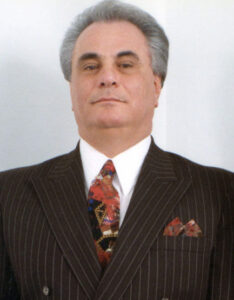
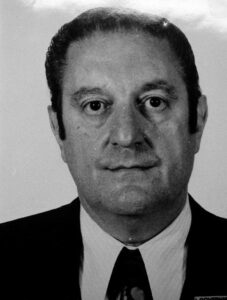 Mafia boss John “Teflon Don” Gotti, so nicknamed after escaping unscathed from several trials during the 1980s, seemed like a guy who was impossible to convict. Gotti was born and educated in New York City. He became head of the powerful Gambino family after boss Paul Castellano was murdered outside a steakhouse in Manhattan in December 1985. There had not been a gang assassination in New York in three decades. Gotti and his colleague Sammy “The Bull” Gravano changed all that. The Gambino family was well-known for its illegal narcotics operations, gambling activities, and car thefts. When Gotti took over, he wanted to show his new-found power, so he expanded the criminal empire over the next five years. Under Gotti, the family grew into the nation’s most powerful Mafia family.
Mafia boss John “Teflon Don” Gotti, so nicknamed after escaping unscathed from several trials during the 1980s, seemed like a guy who was impossible to convict. Gotti was born and educated in New York City. He became head of the powerful Gambino family after boss Paul Castellano was murdered outside a steakhouse in Manhattan in December 1985. There had not been a gang assassination in New York in three decades. Gotti and his colleague Sammy “The Bull” Gravano changed all that. The Gambino family was well-known for its illegal narcotics operations, gambling activities, and car thefts. When Gotti took over, he wanted to show his new-found power, so he expanded the criminal empire over the next five years. Under Gotti, the family grew into the nation’s most powerful Mafia family.
Over the years he was in charge, Gotti managed to avoid conviction several times, despite wide publicity of his criminal activities. Gotti had no problem ordering witness intimidation any time he had a scrape with the law. His plan seemed to be working well, until 1990, when he was indicted for conspiracy to commit murder in the death of Paul Castellano. This time was going to be different. Gravano wasn’t real keen on prison time, and the thought of a deal, any kind of a deal, was very appealing. So, Gravano agreed to testify against Gotti in a federal district court in exchange for a reduced prison sentence. With Gravano’s testimony, John Gotti was found guilty on all 14 counts of conspiracy to commit murder and racketeering, on April 2, 1992. Then, on June 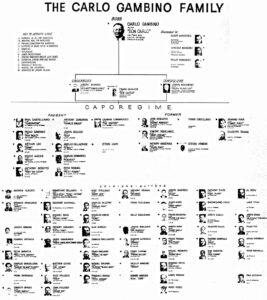
 23, 1992, “Teflon Don” finally ran out of his non-stick coating. He was sentenced to multiple life terms without the possibility of parole. All his prior intimidations had done him no good. He might have been able to get away with it for a while, but now it had all come back to haunt him…and there was no escape.
23, 1992, “Teflon Don” finally ran out of his non-stick coating. He was sentenced to multiple life terms without the possibility of parole. All his prior intimidations had done him no good. He might have been able to get away with it for a while, but now it had all come back to haunt him…and there was no escape.
While his life was essentially over, Gotti had many supporters, and just moments after his sentence was read in a federal courthouse in Brooklyn, hundreds of those supporters stormed the building. They also overturned and smashed cars before being forced back by police reinforcements. It made no difference. While still imprisoned, Gotti died of throat cancer on June 10, 2022.
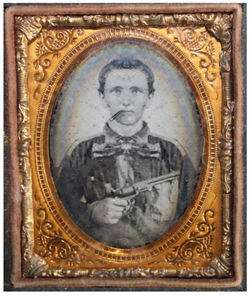 There are some people who are just mean. You can’t look at it any other way. Cullen Montgomery Baker was one of those mean men…a cold-blooded and ruthless killer who left a long trail of bodies across the American Frontier. Baker was a Confederate guerrilla during the Civil War, but he didn’t want to give up the fight once the war was over, so afterward he ambushed reconstructionists, killed former slaves, and generally terrorized the states of Texas and Arkansas for four years.
There are some people who are just mean. You can’t look at it any other way. Cullen Montgomery Baker was one of those mean men…a cold-blooded and ruthless killer who left a long trail of bodies across the American Frontier. Baker was a Confederate guerrilla during the Civil War, but he didn’t want to give up the fight once the war was over, so afterward he ambushed reconstructionists, killed former slaves, and generally terrorized the states of Texas and Arkansas for four years.
Born in Weakley County, Tennessee, on June 22, 1835, to John Baker and his wife, Elizabeth, his father was an honest but poor farmer who also owned cattle. The family moved to Clarksville, Arkansas soon after he was born. Times were no better there, so in 1839, after just a few years, the family moved to Texas, eventually settling in Davis County. There, things looked like they might get better when his father received a land grant of 640 acres, but even with the acreage, the family was still poor, and because of his homespun trousers and bare feet, Cullen was teased by students at school, probably triggering his anger. Though he was a slender and withdrawn youth, he began to fight back. It was at this time, that he obtained an old pistol and a rusty but workable rifle. He practiced diligently until he was very proficient with both weapons.
At the tender age of 15 years, Baker began to drink whiskey. Emboldened by alcohol, he began to challenge both boys and men who annoyed him to “go for your guns.” As often happens when people get hooked on alcohol, he spent much of his time in saloons, where his quick temper got him into several brawls. Soon, he was well known as a hard drinker, a braggart, and generally a quarrelsome and mean-spirited young man. He almost learned his lesson in one fight, when he was knocked unconscious by a man named Morgan Culp, who hit him in the head with a tomahawk. This incident seemingly calmed his temper for a little while, or maybe scared him a little bit, but that wouldn’t last.
Baker was rather a spontaneous man, and so some weeks later, on January 11, 1854, while still wearing a head bandage from the tomahawk incident, Baker married 17-year-old Martha Jane Petty and settled down to a quiet farming life. It looked like the marriage might have been the turnaround moment for him, but he grew tired of this routine and was back to his old ways just eight months later. One night when he was out drinking, he got into an argument with a teenager named Stallcup. As the discussion devolved, Baker became enraged. He grabbed a whip and beat the boy nearly to death. For that, Baker was charged with the crime. He went to the home of witness, Wesley Bailey, and shot him in both legs with a shotgun. He then left him lying in front of his house. Bailey died a few days later, but before Baker could be arrested for the murder, he fled to Perry County, Arkansas, where he hid out at the home of his mother’s brother, Thomas Young, for almost two years.
While there, not bothering to lay low, he stabbed a man named Wartham to death in an argument about horses in 1856 and fled back to Texas. His stay in Texas was short-lived, when he learned he was still wanted for murder in the killing of Bailey, so he returned to Arkansas. While he was gone, his wife Martha gave birth to a baby girl, Louisa Jane, on May 24, 1857. Returning to Texas briefly the following year, he retrieved his wife and daughter. Unfortunately, his wife died on July 2, 1860, and Baker took their child to Sulphur County, Texas. He left her with his in-laws, and that was the last he saw of her. I’m sure his in-laws were thankful for that.
In November 1861, Baker joined Company G of Morgan’s Regimental Cavalry to fight in the Confederate Army. In July 1862, he married a second time to Martha Foster, who was unaware he was wanted for murder. Baker’s name appears on the muster roll for September-October 1862, and he actually received pay through August 31, but by January 10, 1863, he had deserted and was listed on the muster roll as such.
It was at this point that Baker joined a guerilla group called the “Independent Rangers,” loosely associated with the Confederate Home Guard. My guess is that the Confederate regular army was a little “too tame” for his kind of fighting. The guerilla group suited his style better, as their objective was to pursue and capture deserters from the Confederate Army. That work held no real interest for Baker, but it allowed him a certain measure of freedom to do what he really wanted to do, which was to take advantage of most of the men being away at war and committing atrocities of intimidation, rape, theft, and violence. Any man who had property was considered an enemy and was declared to be a Union man to Baker, and therefore fair game. The attacks in some areas became so bad that everyone who could, left the area. Then, shortly after Baker joined the “Independent Rangers,” they began an ongoing feud with another band called the “Mountain Boomers,” who were Union guerrillas…basically having their own war between the North and South. Both bands ran throughout Arkansas, robbing, burning, and murdering indiscriminately…and fighting with each other.
In November 1864, a small band of mostly old men, women, and children, who were trying to escape from the turmoil, started west with their teams and valuables. When the group crossed the Saline River in the Ouachita Mountains, Cullen Baker and the Independent Rangers caught up to them. Baker’s story was that he and his men considered the group’s attempted escape “unpatriotic,” but, in reality, they needed little reason to harass them. When the group refused to return to their homes, Baker drew his pistol and shot and killed their leader. He then assured the rest of the group that he would not kill anyone else, if they agreed to return to their homes. But being the liar he was, as soon as the settlers returned to Baker’s side of the river, he led his 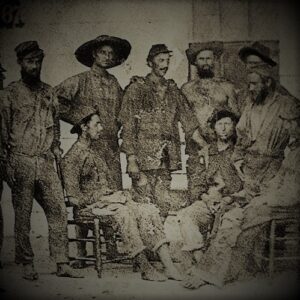 “Rangers” in shooting and killing nine other men and stealing all the valuables. The event became known locally as the Massacre of Saline.
“Rangers” in shooting and killing nine other men and stealing all the valuables. The event became known locally as the Massacre of Saline.
It was at this point that the local citizens had had enough. The began to organize and make active preparations to take out the murderous gang. However, being the stellar, brave men they were, when the ruffians got word of this, they ran, taking their booty and the many horses and mules they had stolen with them.
At the end of 1864, Baker was seen in a saloon wearing a Confederate hat in Spanish Bluffs, Arkansas. He was approached by four African American Union soldiers who asked for identification. With his pistol drawn, Baker turned to face them, shooting and killing a sergeant and the three other soldiers. One report tells that when the war was over, as he was making his way home, he came upon a group of travelers in Sevier County, Tennessee. In the group was a black woman who he began to verbally harass and then shot and killed her.
Following this rampage, he settled down with his wife Martha near the Sulphur River area in southwestern Arkansas, where he became the manager of the Line Ferry. Again, this break from the violence was short-lived. Martha soon took ill and died on March 1, 1866. Apparently, Baker very much-loved Martha and grieved her loss deeply. Still, losing his second wife didn’t stop him from proposing to her 16-year-old sister, Belle Foster, just two months later. Belle rejected his proposal and instead married a schoolteacher and political activist named Thomas Orr. This enrages Baker, who began to harass Orr, trying to pick fights with the man, hitting him over the head with a tree limb, and going to his school to ridicule, curse, and threaten the man in front of his students. I’m sure Belle Foster was thankful she married the man she did, after seeing the horrible acts of the man who had married her older sister.
Reconstruction had begun in Arkansas and Texas around this time, and Baker despised the idea. He and another outlaw named Lee Rames organized a gang that operated out of the Sulphur River bottoms near Bright Star, Arkansas. Baker continued his acts of robbery and murder, along with the Rames gang. They were said to have killed at least 30 people, many of whom were outnumbered, ambushed, or shot in the back. Baker and his gang also traveled to Texas, where he killed John Salmons in retaliation for the killing of Seth Rames, who was the brother of gang member Lee Rames. Baker also killed WG Kirkman, a Reconstruction official, and a man named George W Barron, who had previously taken part as a member of a posse hunting him. Baker was “happy” to kill anyone who annoyed him, or who might have annoyed someone he knew, or might have done the slightest thing against him…real or perceived. The gang continued their outlaw spree in Queen City, Texas, and Texarkana, Arkansas.
On June 1, 1867, he returned to Cass County. In need of supplies, Baker entered the Rowden General Store, helped himself to some items without paying. The proprietor, John Rowden rode with a shotgun to Baker’s house and demanded payment. Seemingly compliant, Baker said he would come back and pay him, but on June 5, he killed Rowden instead. Again, Baker fled to Arkansas, where he recognized by a Union sergeant when he boarded a ferry. He killed the Union officer, but a private was able to get away and reported the murder. With the eyewitness account, Baker became a hunted man, pursued relentlessly by Union forces.
On July 25, 1867, following an argument with several Union Soldiers near New Boston, Texas, which quickly escalated to violence, Baker was shot in the arm in a gunfight in which he killed army Private Albert E Titus. A $1,000 reward was set for his capture, dead or alive.
In December 1867, Baker went to Bright Star, Arkansas, where he met up with several men who were planning a raid on the farm of Howell Smith. They were upset because Smith had hired several freed slaves. In the attack, one of Smith’s daughters was stabbed, another clubbed, and a black man was shot and killed. Still, Smith resisted, and in the ensuing shootout, several of the raiders were wounded, including Baker, who was shot in the leg.
On October 24, 1868, Baker and his gang were reported to have been involved in the killings of Major P J Andrews, Lieutenant H F Willis, and an unnamed black man in Little Rock, Arkansas. Wounded in the attack was Sheriff Standel.
By this time, Baker’s co-leader, Lee Rames, began to get nervous about Baker’s leadership style and felt that his actions would lead to the downfall of the entire gang. Rames defied Baker, who backed down, and the gang broke up in December 1868. All members, except “Dummy” Kirby, sided with Rames. Baker and Kirby went to Bloomburg, Texas, to the house of Baker’s in-laws in January 1869. It would be there that Cullen Baker and “Dummy” Kirby would die on January 6, 1869.
Exactly how they were killed is unknown. One version says that “his father-in-law and friends laced a bottle of whiskey and some food with strychnine and both men died from poisoning. Afterward, their bodies were riddled 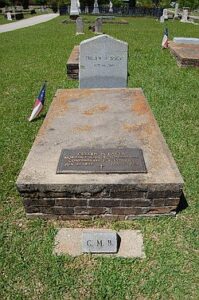 with bullets. Another version says that Thomas Orr, with whom Baker had long feuded, led a small band of men who ambushed Baker and Kirby at the Foster home, shooting and killing them.” In reality, it doesn’t matter how they died, because so many people were glad that Baker was gone, that after the men were killed, their bodies were dragged through the town of Bloomburg and then taken to the US Army outpost near Jefferson, where they were placed on public display. Thomas Orr was said to have collected some of the reward money offered for Baker. Baker was buried in the Oakwood Cemetery in Jefferson, Texas. Though he was a deserter from Morgan’s Squadron, the Confederate cavalry unit is shown on his grave marker.
with bullets. Another version says that Thomas Orr, with whom Baker had long feuded, led a small band of men who ambushed Baker and Kirby at the Foster home, shooting and killing them.” In reality, it doesn’t matter how they died, because so many people were glad that Baker was gone, that after the men were killed, their bodies were dragged through the town of Bloomburg and then taken to the US Army outpost near Jefferson, where they were placed on public display. Thomas Orr was said to have collected some of the reward money offered for Baker. Baker was buried in the Oakwood Cemetery in Jefferson, Texas. Though he was a deserter from Morgan’s Squadron, the Confederate cavalry unit is shown on his grave marker.
Some people have romanticized him for his defense of the “Southern honor,” but the reality is that Baker was a ruthless killer who killed anyone who angered him, regardless of their loyalties. It is thought that he killed between 50-60 people, and authorities and historians alike rank him among the most ruthless killers who ever lived.
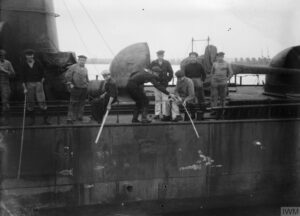
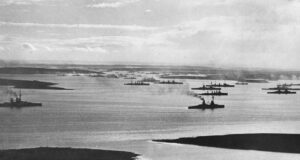 After the November 11, 1918 German surrender in World War I, the German fleet was interned at Scapa Flow under the terms of the Armistice of 11 November, while negotiations took place over its fate. There was talk of the fleet being divided between the Allied nations, and there were those who really wanted that, but this brought the fear that the British would seize the ships, and the Germans worried that if the German government at the time might rejected the Treaty of Versailles and resumed the war effort, the newly confiscated German ships could be used against Germany. Amid all the speculation, Admiral Ludwig von Reuter decided to scuttle the fleet.
After the November 11, 1918 German surrender in World War I, the German fleet was interned at Scapa Flow under the terms of the Armistice of 11 November, while negotiations took place over its fate. There was talk of the fleet being divided between the Allied nations, and there were those who really wanted that, but this brought the fear that the British would seize the ships, and the Germans worried that if the German government at the time might rejected the Treaty of Versailles and resumed the war effort, the newly confiscated German ships could be used against Germany. Amid all the speculation, Admiral Ludwig von Reuter decided to scuttle the fleet.
Scapa Flow was a naval base in the Orkney Islands in Scotland. When the German ships arrived, they had full crews and in all, there were more than 20,000 German sailors aboard, the number of sailors was reduced in the ensuing months. When the full fleet was at Scapa Flow, there were 74 ships there during negotiations between the Allies and Germany over a peace treaty that would become Versailles. The discussion was about what to do with the ships, since they didn’t really want Germany to have a full fleet ready, should they decide to wage war again. The French and Italians wanted a portion of the fleet, but the British wanted them destroyed. They were concerned about their own naval superiority, should the ships be distributed among the other Allied nations.
The Germans didn’t want their ships in the hand of their enemies, so Admiral Ludwig von Reuter began to prepare for the scuttling in May 1919, after hearing about the potential terms of the Versailles Treaty. Shortly before the treaty was signed on June 21, Reuter sent the signal to his men. The men began opening flood valves, smashing water pipes, and opening sewage tanks. As the scuttle was taking place, nine German crew members who abandoned ship and attempted to come ashore were shot by British forces. As the ships were being scuttled, the intervening British guard ships were able to beach some of the ships. In all, 52 of the 74 ships were sunk. While he wouldn’t say so out loud, British Admiral Wemyss was delighted that the ships were 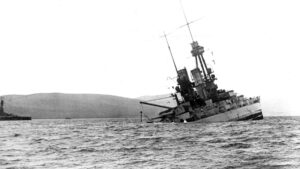
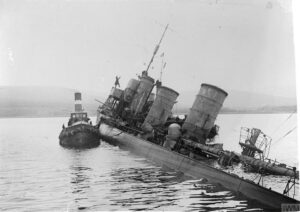 sunk, because that meant they wouldn’t be distributed to the French and Italians navies. Since the scuttling, many ships have been refloated and salvaged in the years since. Nevertheless, some remain in the seas at Scapa Flow. Those that remain are popular diving sites and a source of low-background steel.
sunk, because that meant they wouldn’t be distributed to the French and Italians navies. Since the scuttling, many ships have been refloated and salvaged in the years since. Nevertheless, some remain in the seas at Scapa Flow. Those that remain are popular diving sites and a source of low-background steel.

